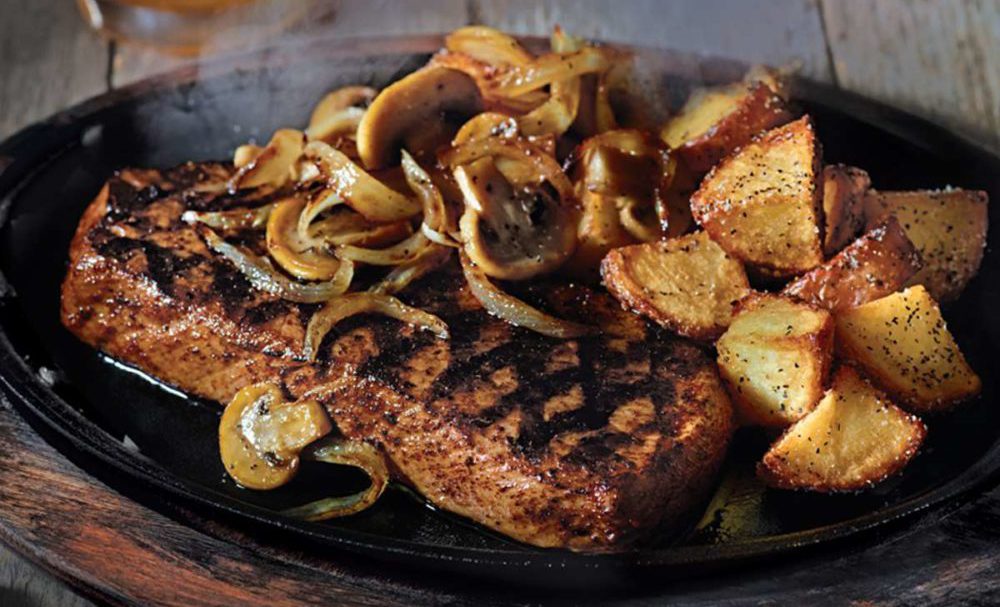Between 1965 and 1980, four culinary icons emerged : TGI Fridays, Ruby Tuesday, Chili’s, and Applebee’s. They all offered similarly regrettable American meals, with a level of ambience a step above fast food: table service, and wall decor consisting of dusty faux antiques and celebrity photos misleadingly implying star-studded restaurant visits.
While all four chains were profitable, the companies would struggle, for the next fifteen years or so, with loss of revenue due to broken plates. At the root of this phenomenon were customers angry about the “greens” on their plates (parsley garnish), who would often slam down their plates in protest. The companies also experienced exorbitant worker compensation claims from servers and bussers who suffered lacerations trying to clear the tables of broken dishware.
At the same time, a common customer complaint was that entrees lacked grease. Phone centers were understaffed to handle the call volume regarding grease and parsley comments. While restaurant staff were encouraged to smile and upsell appetizers, or squat down in front of booths while taking orders in an effort to remind customers that staff were real people with faces that could get too close, kitchens were places of emotional breakdowns and tears.
But in 1996, everything changed, with the entrance onto the restaurant scene of a man named Ralph Butterdump. Butterdump was a fast-talking fixer and slick consultant who rose to the top of the hospitality industry due to his reputation of cutting out the middleman. Butterdump slashed middle management and other inefficiencies wherever his services were used, and restaurant CEOs were clamoring to meet with him.
Chili’s desperately offered to pay Butterdump twice his usual consulting fee. As a result, Butterdump worked around the clock, looking for opportunities to cut costs. “Meals directly from skillets,” he finally asserted with swagger. He, like most of Chili’s customers, also hated parsley, due to many headshots bungled by the garnish hiding in his teeth. In fact, many people wonder in hindsight if Butterdump had any connection to The Great Parsley Farm Fires of 1995, which wiped out nearly all the world’s parsley supply. In any case, parsley disappeared from the kitchens of Chili’s – and nearly everywhere, abruptly.
The following is a brief history of some of the groundbreaking changes Butterdump implemented in the four restaurant chains:
- By the end of 1996, nearly every Chili’s entree arrived at the customer’s table on a splattering, grease-heavy cast-iron skillet. Customers were ecstatic, and if they weren’t, no one could hear their complaints above the din of the sizzle in stereo. Overall satisfaction ratings went through the roof. Customers were excited about the increase in grease. They were surprised to taste their fajitas very hot, and not just in spice level. And those who were unhappy were unable to destroy in anger the germ-infested wooden trivet on which the skillet was presented.
- 1997: Applebee’s hired Butterdump next, and for them the bold trendsetter brought in two initiatives, in addition to skillet meal logistics training. Changes included pasta delivered in scalding pots, and a lavish dessert of one dozen gooey chocolate chip cookies on a blazing hot baking sheet. Customers went wild. And servers’ jobs got easier: no expo was needed, only a potholder at the ready.
- 1998: Not to be left behind, TGI Fridays then hired Butterdump. Butterdump assisted Fridays in the implementation of the skillets, pots, and cookie sheets, but suggested a further groundbreaking change: small soda machines on tables. The server was relieved of another duty, and customers could indulge in corn syrup on demand. While it was lauded a success at first, the change ended up being much more costly than expected, and required each franchise to have a soda machine repairperson on staff. Fridays would eventually nix the soda machines and instead just deliver two liters of soda to tables. (Friday’s soda history partially explains the sticky surfaces of its franchises.)
- Meanwhile, Butterdump’s net worth was said to be over $15 million that year, and rumors circulated of rowdy parties hosted by the “skillet king” that rivaled those of rock stars and Hollywood personalities. Wherever Butterdump was, prostitutes and amphetamines were never far.
- 1999: Ruby Tuesday hired Butterdump nonetheless. While he did succeed in implementing some profitable changes, he was also busted in a undercover sting due to attempts to cook skillet meth in various Ruby Tuesday locations in Florida and Arkansas. Butterdump has remained in a Jacksonville prison ever since, running the kitchen.
Over time, many of Butterdump’s implemented strategies have been scrapped as failures. Straight-to-table pasta pots proved disastrous when several servers forgot to empty the boiling water before bringing to customers. Hot cookie sheets cracked the laminate surfaces of so many booths that restaurants went back to serving cookies other ways. Tabletop soda machines were not profitable at all, ever. And some skillets burned customers, prompting a return to plates for many entrees.
But some skillets remain. Each of the four restaurants still retains at least one skillet dish on their menu today. The next time you enjoy a Sizzlin’ Chick’n ’N’ Cheez, know that you’re taking part in a bit of living Butterdump restaurant history.

